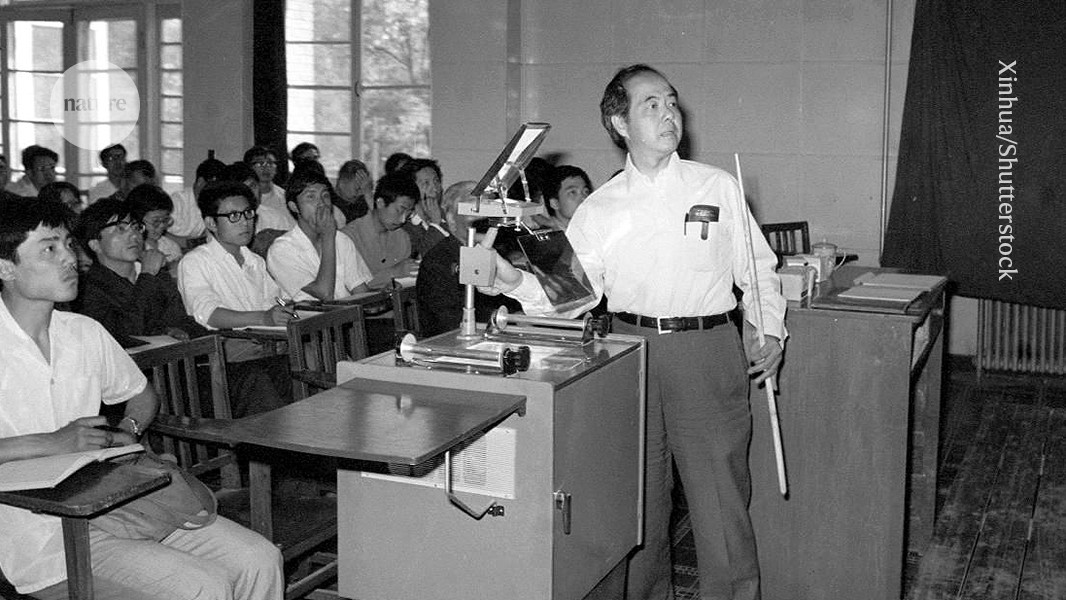
- Select a language for the TTS:
- UK English Female
- UK English Male
- US English Female
- US English Male
- Australian Female
- Australian Male
- Language selected: (auto detect) - EN
Play all audios:
Outside the Institute of High Energy Physics in Beijing stands a 5-metre-high metal sculpture. The round, swirling shape of ‘The Tao of All Matter’ invokes the yin and yang of ancient
Chinese philosophy — a representation of the inseparable opposites said to form the basis of all things — as well as the ring of the modern particle accelerator a few dozen metres away. The
designer was physicist Tsung-Dao (T. D.) Lee. An artistic, inventive and boundary-breaking physicist, in 1957 Lee became one of the youngest winners of a Nobel prize at 30 years old. He
shared the award with his compatriot Chen Ning Yang for their work on broken symmetry in particle physics. Chinese-born but based in the United States for most of his career, Lee, who has
died aged 97, promoted engagement between US and Chinese physicists. After China’s Cultural Revolution (1966–76), it was difficult for US universities to evaluate the abilities of Chinese
applicants, because they did not know the assessment criteria used in China. Lee set up the China-US Physics Examination and Application system, through which US physicists set exams for
Chinese universities to administer, and then went to China to mark them. On the basis of the results, US universities awarded scholarships to nearly 1,000 Chinese students between 1979 and
1989. Lee’s own education in Shanghai had been interrupted by the 1937 Japanese invasion of China, and by 1945 he was studying physics at the National Southwestern Associated University in
Kunming, China. There, at 19 years old, he received a fellowship from the Chinese government to study in the United States, where he completed a PhD at the University of Chicago, Illinois,
with the Italian American nuclear physicist and Nobel prizewinner Enrico Fermi as his adviser. He spent the rest of his career at Columbia University in New York City. How a forgotten
physicist’s discovery broke the symmetry of the Universe Lee earned his own Nobel in one of the most remarkable episodes of twentieth-century science. Physicists were baffled by two
particles, known as _τ_ and _θ_, that were identical except that they decayed in different ways. Treating them as distinct particles created insoluble theoretical problems, whereas treating
them as identical defied the fundamental structure of physics known as parity — the idea that objects always behave in the same way as their mirror images. In 1956, Lee worked on the problem
with Yang while the two were spending the summer at Brookhaven National Laboratory in Upton, New York. Colleagues remember hearing them shouting at each other in their offices in Chinese
and English, and drawing equations in the sand on visits to the beach. Did physicists, the two asked, really know that parity structured the ‘weak interaction’ that governed decays of _τ_
and _θ_? After wading through a 1,000-page book detailing 40 years of work on the subject, they realized that that aspect of parity had not been tested. On 22 June 1956, Lee and Yang sent an
article to _Physical Review_ with the title ‘Is parity conserved in weak interactions?’. The journal’s editor insisted that question marks in paper titles were unscientific and changed it
to ‘Question of parity conservation in weak interactions’ (T. D. Lee and C. N. Yang _Phys. Rev._ 104, 254; 1956). Lee and Yang struggled to interest experimenters in testing a hypothesis
widely regarded as preposterous. Only Chien-Shiung Wu at Columbia agreed. She set up an experiment to detect β-decay — the emission of β-particles from nuclei — in ultracold radioactive
cobalt. At the tail end of 1956, her team announced that parity was indeed violated in the weak interaction. As another Columbia colleague, Nobel-prizewinning physicist Isidor Rabi, said at
a press conference: “A rather complete theoretical structure has been shattered at the base and we are not sure how the pieces will be put together.” By the end of the year, Lee and Yang had
been jointly awarded the Nobel Prize in Physics for their discovery. Lee and others felt that Wu deserved a share of the prize, but she never received it. ENJOYING OUR LATEST CONTENT? LOGIN
OR CREATE AN ACCOUNT TO CONTINUE * Access the most recent journalism from Nature's award-winning team * Explore the latest features & opinion covering groundbreaking research
Access through your institution or Sign in or create an account Continue with Google Continue with ORCiD






![[withdrawn] po18 8ex, mr john wells and mrs susie wells: environmental permit application advertisement](https://www.gov.uk/assets/static/govuk-opengraph-image-03837e1cec82f217cf32514635a13c879b8c400ae3b1c207c5744411658c7635.png)

